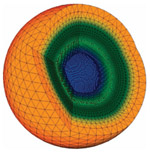Department of Physics and Astronomy: Publications and Other Research

Robert Streubel Papers
Document Type
Abstract
Date of this Version
1-1-2015
Citation
Published in 2015 IEEE International Magnetics Conference (INTERMAG). Conference held May 11-15, 2015, Beijing, China; Session BE-04
doi: 10.1109/INTMAG.2015.7156673
Abstract
A further increase in performance of state-of-the-art spin-electronics can be achieved by either miniaturizing its functional components or harnessing the third dimension. The first route, however, faces physical limitations as properties of nanostructures and their response to external stimuli can drastically change in reduced dimensions. An alternative way is to go from planar 2D structures to 3D architectures [1]. Such 3D functional elements can be obtained for example by rolling up initially planar strained thin films into Swiss roll like objects with multiple windings (Fig. 1a). A major advantage of this technology platform is the possibility to fabricate compact multifunctional 3D architectures with film qualities similar to those of planar systems and peculiar properties only occurring in hollow cylindrical objects [2-4]. Their magnetic properties are generally characterized by integral techniques, such as ferromagnetic resonance [2], magneto-robotic probing [3], anisotropic magneto-impedance/magnetoresistance [4,5] and cantilever magnetometry [6], or Kerr [7] and x-ray [8,9] microscopies. However, the underlying microscopic magnetization configuration can in general not be retrieved by such means. While already established magnetic neutron tomography [10] and electron holography [11] may be applied to probe either microscopic or nanoscopic samples, a technique that provides direct access to the magnetization of 3D-shaped mesoscopic objects with nanometer spatial resolution of the magnetic contrast is highly demanded but not yet developed.
Included in
Atomic, Molecular and Optical Physics Commons, Condensed Matter Physics Commons, Other Physics Commons


Comments
Published by IEEE. Used by permission.